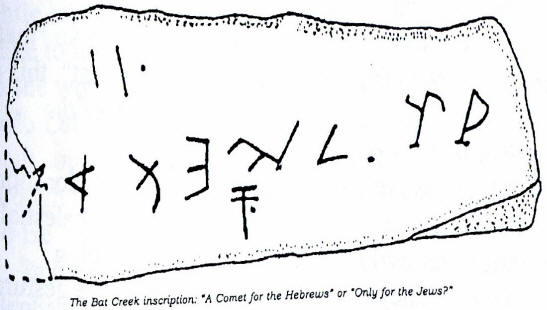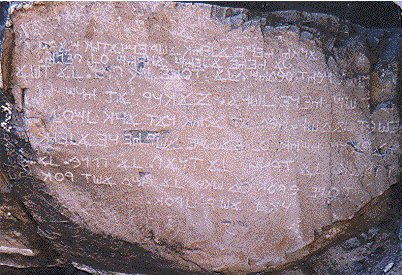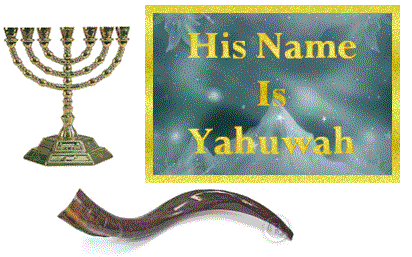
Chapter 13
Testimony from the American Indians
James Adair is the earliest source information concerning the American Indians. He observed several Israelite characteristics in the southern American Indians.
James Adair was a backwoods preacher that lived and traded with the Southern Indians some forty years; he was called, by various writers, an Englishman, a Scotchman, and an Irishman. He was of a noble birth, whose family was of Earldom. His book was first published in London in 1775, and the main reason he wrote this book was to give evidence to show that the Indians were the lost tribes of Israel.
In recent times many stones have been turned up in America with ancient writings on them. These writings were compared to writings in the old world, and have been identified. These writings were found to be Arabic, Basque, Celtic, Cuneiform, Egyptian, Gaelic, Greek, Iberian, Libyan, Norse Runic, Numidian, Phoenician, and yes, there is ancient Hebrew inscriptions as well. One of these inscriptions is the "Bat Creek Stone" discovered in Loudon County Tennessee....

Usually interpreted "Only for the Yehudim" (Jews)
With inscriptions like this popping up, its easy to see how someone could come to such conclusions of the American Indians being the lost tribes of Israel, but James Adair had no rocks to go by.
Moses warned the Israelites that if they departed from the covenant faith that "YAHUWAH shall scatter thee among all people, from the one end of earth even unto the other." Deuteronomy 28:64. Most scholars interpret this to mean everywhere but America.
It is not the burden of this book to belabor the point too long, but it is in order to at least mention some points, because they are so interesting.
The American Indians did practice certain aspects of the Hebrew religion. "Cotton Mather in Boston, in the course of a long series of extraordinary letters to the Royal Society in London, drew attention to the existence, in Connecticut, of a tribe of Indians which practiced circumcision." America B.C. p. 17
Even today the Cherokee nation honors the 7th day of the week. The numbers 4 and 7 are sacred to them, largely because it is the fourth commandment that sanctifies the seventh day.
A few evidences that James Adair listed:
1) They constructed their place of worship so "that their backs are to the east, and faces to the west", this is after "the Jerusalem copy"! Adair's History of the American Indians p. 118
2) "They do not pay the least perceivable adoration to any images, or to dead persons; neither to the celestial luminaries, nor evil spirits, nor any created being whatsoever. They are utter strangers to all the gestures practiced by the pagans in their religious rites." Ibid p.20
3) "The Germans among them, frequently say "Yah-yah", as an affirmative, they call them Yah-yah Algeh, Those of the blasphemous speech'; which strongly hints to us, that they still retained a glimpse of the third moral command delivered at Sinai." Ibid p.70
4) They "observed a weekly sabbath". Ibid p. 79 [This Sabbath is the seventh-day, as the Cherokee observe and many Seminole, the same day which Jews observed]
5) When they go to war they always carried their "sacred ark" with them! Ibid p. 162
6) They rejoiced "at the appearance of the new moon." Ibid p. 20
7) They "observed a year of jubilee"! Ibib p. 226
8) They used the word "HalleluYah" in their religious gatherings etc.
James Adair, throughout his book, notes the set-apart name used by these American Indians as Yo He Wah. Josiah Priest, in his book American Antiquities p. 76 bears out that this was from the Choctaw and Florida Indians.
I remember attending a Feast of Tabernacles down in Kerrville, Texas where we had a formal reading of the book of Deuteronomy, where persons would take turns reading from the Scriptures. When the readers came to capital LORD (which indicates in the King James Version where the tetragrammaton originally appeared in the Hebrew Scriptures), some readers would say Yahweh, while others would say YAHUWAH, but when one sister came to it, she was uncertain of the correct pronunciation, so she would simply say the four letters "Yod He Vav He". Later on she began using "Yod He Waw He". To me, it sounded much like what Adair heard, possibly through time the three letters "Yod He Waw" turned into Yo He Wah.
In the old world, the form YHW was used by Jews in Elephantine Egypt.9
Also worth noting is that James
Adair mentioned the Hebrew word ![]() which Strong's shows to be
"huw", which Adair transliterated as
Hewa, meaning he or she. Adair did this
because of the way it is vowel pointed.
which Strong's shows to be
"huw", which Adair transliterated as
Hewa, meaning he or she. Adair did this
because of the way it is vowel pointed.
Another statement by Adair is worth noting:
"It is plain that where the Indians have not been corrupted by foreigners, their customs and religious worship are nearly alike; and also that every different tribe, or nation of Indians, uses such-like divine proper name, and awful sounds, as Yah-WahHetovah,&c. being transpositions of the divine essential name, as our northern Indians often repeat in their religious dances. As the sound of Yah-wah jarred in Laudon's ear, he called it Java, in resemblance to the Syriac and Greek method of expressing the tetragrammaton, from which Galatinus imposed it upon us, calling it Jehowah, instead of Yohewah." History of the American Indians p. 218
Notice in the above statement the word "Java", a Syriac and Greek way of expressing the tetragrammaton. The Syriac nor Greek have the letter "J" in their alpha-beta, nor do they have a "V"! It must have been a modem way of expressing it, just as the translators of the Ante-Nicene Fathers put "Jave" in the text of an early Greek writer. The reason for bringing this out, is that YAHUWAH would be transliterated correctly into Greek as Ioua instead of Iaue, as Josephus related to the Greeks, which he did say consisted of "four vowels", which leaves out the "J" and the "V"!
To this day the Cherokee call the Creator "Yowa", which does resemble "Iowa", which would be a short form. J.C. Beltrami called the Iowa river the YAHOWA10 river, interesting to say the least.
Some have argued the Hebrew connection of the Hopi, that their ways were similar to the Baal worship of the Hebrews, the Kabalah connection. The Hopi have a word which describes from whence life first began, this word is "yayva".
In the Book of the Hopi by
Frank Waters, the Sun God is referred to as the Creator by the
name "Taiowa", a combination of Tau and iowa. The
Paleo-Hebrew Tau ![]() , is a symbol of the sun, also
called the "MARK" or cross. The Hebrew Aleph and
Tau are the first and last letters in the Hebrew alephbet.
"Thus saith YAHUWAH the King of Israel, and His redeemer YAHUWAH
of hosts; I am the first, and I am the last; and beside Me there
is no Elohim." Isaiah 44:6. The Greeks related it as Alpha
and Omega as in Revelation 1:8. Other books refer to the
Sun Spirit as Tawa. The Pueblo also call the creator
godTawa.
, is a symbol of the sun, also
called the "MARK" or cross. The Hebrew Aleph and
Tau are the first and last letters in the Hebrew alephbet.
"Thus saith YAHUWAH the King of Israel, and His redeemer YAHUWAH
of hosts; I am the first, and I am the last; and beside Me there
is no Elohim." Isaiah 44:6. The Greeks related it as Alpha
and Omega as in Revelation 1:8. Other books refer to the
Sun Spirit as Tawa. The Pueblo also call the creator
godTawa.
"Yahoya" is the deity of Bear Clan at Shongopovi.11
The Chickasaw Indians call the Creator "Chihoowah". In Arizona there is a county and tribe of Indians called "Yavapai", meaning sun people, pai, meaning people, and Yava meaning sun. There are many examples throughout history of the sun being confused with the deity. These Indians literally make prayers to the sun. We know from Scripture, in Ezekicl 8 for example, that this is not only an error but an abomination. However, YAHUSHUA said that the sun was a symbol that pointed to Himself when He said, "I am the light of the world." John 8:12. The sun is the light of this world, which enables us to see about us and not wander around in darkness. What the Catholic church has done is take something that is a symbol of YAHUSHUA, and worship the symbol instead of what the symbol represents, which is the Messiah Himself.
Another example is that the Saviour said, "If any man will come after Me let him deny himself, and take up his cross and follow Me." Matthew 16:24. The Catholic takes this literally and wears a cross around their neck.
Obviously they are in darkness and have not seen the "Sun of righteousness."
In Texas, the Catholic priests established the Alamo as a mission for the very purpose of "Christianizing" the Indians. These areas, near the border of Mexico, were heavily Catholicized! Thus, my point with the Yavapai Indians of Arizona. Yahushua's missionaries are needed out west, to help correct these errors.
Another one that is a bit speculative, but worth considering, is another tribe in Arizona called Havasupai. While passing down the interstate in Arizona, and seeing the word "Havasu" on a sign, caused me to ponder a bit. I already knew that "pai" means "people". So what is left is Havasu; then I thought, what if this "H" is an English translation from the Spanish "J", that would make it appear more like Javasu. Then this Spanish "J" would lead us back to an old "I" or "Y" in the Old World.
Well sure enough, in doing some research into this, several writers expressed it like I thought they might.
Havasua Pai - Ewing in Great Divide, 203, Dec. 1892
Jabesua - Garces (1776). Diary, 340, 1900
Java Supais - Baxter in Harpers Mag., June 1882
Javeusa - Escudero, Noticius de Chihuahua, 228, 1834 (misquoting Garces)
Yabipals - Garces (1776), Diary, 340, 1900
Yavai Suppai - Arthur (1882) in Indian Aff. Rep., 297, 1886
Yavipai Jabesua - Bandelier in Arch, Inst. Papers III, 112, 1890
Yavipai Javesua - Orozco y Berra, Geog., 1864 (after Garces)
Yuva Supai - Corbusier in Am. Antiq., 276 Sept. 1886
Notice the
"Jabesua", the "Jabe" resembles the way Theodoret
and Epiphanius expressed the tetragrammaton which was ![]() . Also notice
"Yuva", it is understood that "Yu" is a corruption of
Yahu, the first part of the set-apart name. Example: the Arabs call Joseph "Yusef,
though Strong's has Yehoseph; originally it was
Yahuseph.
. Also notice
"Yuva", it is understood that "Yu" is a corruption of
Yahu, the first part of the set-apart name. Example: the Arabs call Joseph "Yusef,
though Strong's has Yehoseph; originally it was
Yahuseph.
"Havasupai", we are told, means "the blue green people", breaking it down:
Hava = Blue, Su = Green, Pai = people.
On the surface, this seems illogical. Why would anyone call themselves the Blue-green people? But there is a deeper two-fold meaning...
Blue represents "heaven", as it is blue when you look up at a clear sky in the day time. Green represents the "earth". Heaven came to earth, or YAHUWAH came to earth in YAHUSHUA (some sacred namers like to say Yahuahshua; I've even heard Yahweshua).
The ancients used to associate a virtuous idea with the set-apart name, and from this stemmed many words, like jus = law, judge, justice, jury, jurisprudence etc. Take for instance the name "Jupiter"; the "Ju" is a corruption of "Yahu". A quick example: Judah, in Hebrew is Yahudah. The prophet/king Jehu (originally Yahu) in the Septuagint is "Iou", the English text beside it has "Ju". Jupiter was associated with "the heavens", as many reference works bare out; yea, even the Bible in Acts 19:35, "the image which fell down from Jupiter". Newer versions put "the image which fell down from heaven."
Piter is the same as pater, pader, padre, fader, meaning father, in this way Jupiter would mean heavenly father. What the Romans did was make an image of what they thought god looked like, which is forbidden in the Ten Commandments. At first, it was intended to only represent what El was like; then a couple of hundred years ago, by and by, they start worshipping it. Idolatry usually doesn't start over night, but I still say men are more in the "image of Elohim" than some statue. Give glory to Elohim, wear a beard!
Back to the subject:
David wrote, "the heavens shall declare His righteousness." Ps. 50:6. The heavens are blue, but blue also represents "the law". Lets finish the text, "for Elohim is judge Himself." There are hints in Scripture that the Ten Commandments were written on sapphire stone from YAHUWAH's very throne (see Ex. 24:10 & Ezek. 1:26). Dan means "judge", and the stone in the breast plate, worn by the high priest of Israel for the tribe of Dan, was sapphire (Sapphire is the fifth stone listed Ex. 28:18 and Dan is the fifth son listed in Gen 29 & 30).
| YAHUWAH also told Mosheh, "Bid the children of Israel to make fringes, and be sure that when you make it, put a "ribband of blue", why? "that you may look upon it, and remember all the commandments of YAHUWAH, and do them; and that you seek not after your own heart and your own eyes, after which you use to go a whoring: that ye may remember, and do all My commandments." Numbers 15:38,39. |
|
Green also represents "living", to be "alive" in YAHUSHUA. In the book of Revelation, chapter 9:4, the angel is commanded not to hurt "any green thing" or those written in the Book of Life, who have "life" in them. But the text continues, "but only those men which have not the seal of Elohim in their foreheads." Rev 9:4.
They receive not the set-apart name which is part of the great seal, Name - YAHUWAH, Title - Creator, and Jurisdiction - Heaven & Earth, as brought out from the fourth commandment. Those who are not a green thing, receive not the love of the truth that they might be saved.
This is the hidden message of the Blue-green folks. This same concept is throughout Scripture. YAHUSHUA the Messiah told the rich young ruler and tells us today, "If thou wilt enter into LIFE, keep the commandments." Matthew 19:17, with a reference to Leviticus 18:5
John also wrote, "Blessed are they that do His commandments, that they may have right to the tree of LIFE." Revelation 22:14 KJV
There is also a large rock on Mystery Mountain near Los Lunas, New Mexico, which is inscribed with the ten commandments. Some scholars believe it to be some form of Paleo-Hebrew, others Phoenician Cyrus Gordon thought it to be Samaritan. The inscription is certainly authentic, as it was inscribed in a nearby stone, the documentation of a lunar eclipse; possibly how Los Lunas got it's name. Researchers discovered that there was a lunar eclipse there in 107 B.C.E.
The set-apart name is inscribed
therein as ![]() .
.

The Testimony from the American Indians have one common thread that runs through them all, and that is the "a" sound at the ending of the set-apart name.
References
9) The New 20th Century Encyclopedia (2nd Ed.) of Religious Knowledge p. 886
10) A Pilgrim in Europe and America Vol. II p. 151 byJ.C. Beltrami (1828)
11) Book of the Hopi by Frank Waters
